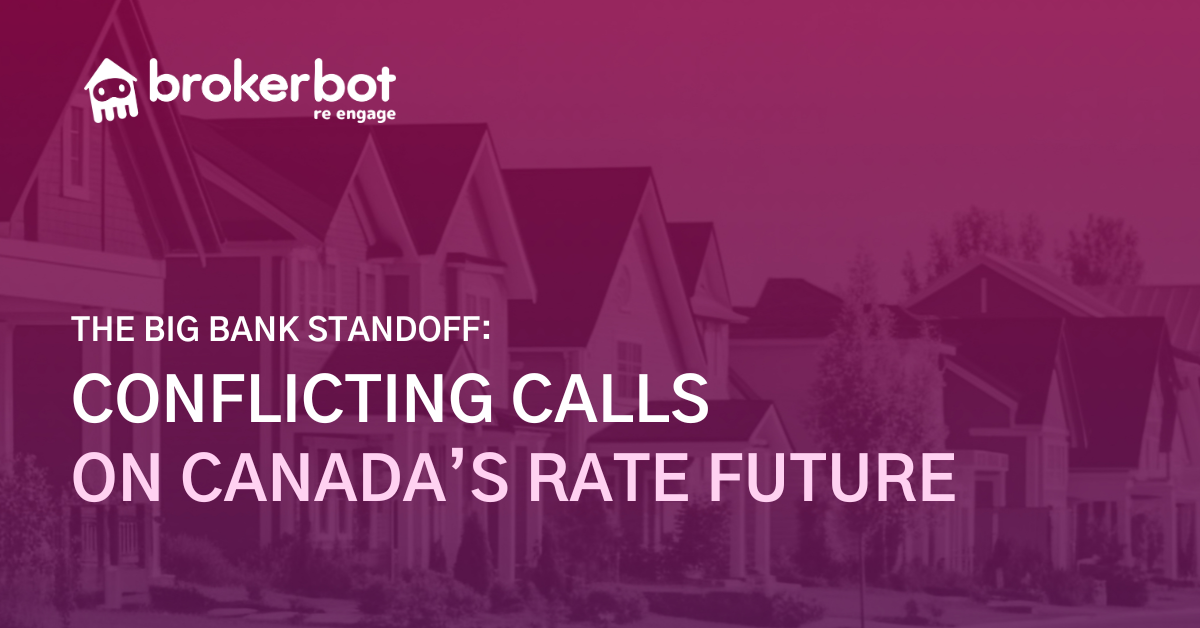The rate-cutting cycle that defined 2024 and most of 2025 is running out of steam. And now, Canada's biggest banks publicly disagree about what comes next—a rare admission that nobody knows where this ship is headed.
For months, the conversation was straightforward: how fast will rates fall? But that question has been quietly replaced by a much trickier one: when will they start rising again?
The Forecast Free-For-All
The Bank of Canada's policy rate currently sits at 2.50%, slashed from a peak of 5% last year. There's a broad consensus that we'll see at least one more cut (likely 25 basis points) by the end of 2025, bringing the rate to 2.25%. After that? It's a choose-your-own-adventure novel.
BMO is the most optimistic, forecasting the rate will drop to 2.00% by early 2026 and stay there. RBC and TD are more cautious, expecting the rate to hold at 2.25% throughout the year. But Scotiabank and National Bank have flipped the script entirely; they're now calling for rate increases in the second half of 2026, with Scotiabank predicting a return to 2.75%.
Why the split? The economy is sending mixed signals. Growth is sluggish, unemployment is climbing, and GDP is barely treading water. All of that normally screams "cut rates." But inflation? It's not budging fast enough. Core inflation measures are still hovering around 3%, well above the Bank of Canada's 2% target.
As Scotiabank economist Jean-François Perrault put it: "The conflict between weak growth and high inflation is on full display."
Bond Markets Are Signaling a Floor
While the Bank of Canada controls short-term rates, bond markets set the tone for fixed mortgages. And right now, bond yields tell a different story than policy rates.
In its latest fixed income monitor, National Bank noted that "any rate relief along the Government of Canada curve will be modest, and longer-term yields should remain range-bound for the foreseeable future." Translation: bond yields have likely bottomed out, and fixed mortgage rates have limited room to drop further.
The 5-year Government of Canada bond yield (the benchmark that drives fixed mortgage pricing) is expected to hold near 2.65% by year-end before gradually climbing to 3.0% by Q3 2027. That's not great news for borrowers hoping fixed rates will keep melting lower.
Fixed Rates Could Rise Even As Policy Rates Fall
Here's where it gets strange. Variable mortgage rates will continue to fall if the Bank of Canada cuts again. But fixed mortgage rates? They could actually increase over the same period.
Oxford Economics is forecasting that 5-year fixed mortgage rates will edge higher to 5.2% by early 2026, even as the policy rate drops to 2.25%. The reason: elevated risk premiums and bond market jitters about persistent inflation and global uncertainty.
This divergence creates a headache for mortgage brokers and agents trying to guide clients. The old playbook of "go variable when rates are falling, doesn't work as cleanly when fixed rates are decoupling from policy rate movements.
What This Means for Your Business
If you're a broker, this is the time to sharpen your rate strategy conversations. Clients who lock into a variable rate today might save money in the short term, but if Scotiabank's forecast is correct, those savings could evaporate by mid-2026. Meanwhile, clients betting on fixed rates dropping further might be disappointed, or worse, blindsided by increases.
For agents, this uncertainty is already showing up in buyer behavior. Affordability hasn't improved as much as people hoped, and the mixed signals from the banks aren't helping. Pre-approvals are expiring faster, and clients are getting cold feet.
Appraisers, meanwhile, need to monitor regional rate sensitivity. If rates reverse course next year, markets with higher proportions of variable-rate holders could feel more pressure.
The Bottom Line
The banks don't agree because the data doesn't agree. Growth is weak, but inflation is stubborn. The Bank of Canada should cut rates to support the economy, but doing so risks reigniting inflation. It's a tightrope walk, and nobody's sure which side we'll fall off.
The next rate decision is October 29. Expect one more cut to 2.25%. After that, keep your eyes on core inflation. If it stays above 2.5%, the hawks will start circling. If it drops, the doves might keep the cuts coming.
But here's the reality: 2026 is going to be messy. And the brokers, agents, and industry pros who prepare for uncertainty now will thrive when the dust settles.
Big question to chew on: If the banks can't agree, how are you positioning clients who need certainty?


.png)
.png)
.png)
.png)
